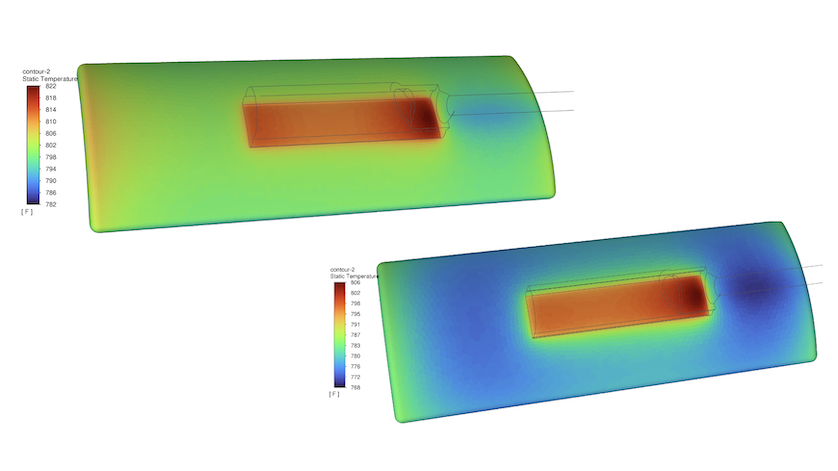
This article is a continuation of “How Butter-Pad Affects Tubeskin Thermocouple Accuracy.”
WIKA conducted a series of tests – both in the field and using computational fluid dynamics – to evaluate the accuracy of tubeskin thermocouples (TSTCs) when installed on a butter-pad vs. on a bare tube. We also varied the weld material’s orientation (transversal vs. longitudinal), its emissivity values (ε = 0.45, 0.67, and 0.85), and subjected the sensors to different operating conditions (firing at 6.9 MMBtu/hr and 12.7 MMBtu/hr).
Based on the data, we arrived at several conclusions as well as two ways to improve the accuracy of TSTCs when the sensors are not installed directly on a bare furnace tube.
How Butter-Pads Impact Tubeskin Thermocouple Accuracy: Observations and ways to improve accuracy
From the data, we observe the following:
- The surface finish of the butter-pad had a definite impact on its temperature distribution and, hence, the accuracy of the thermocouple mounted on it. Increasing the butter-pad’s emissivity value from 0.67 to 0.85 increased its surface temperature by 21°F and increased its temperature deviation (from bare tube) by 20°F (see Table 2).
- Regardless of the butter-pad’s emissivity value, the product installed on a butter-pad read higher as compared to when it is installed on a bare tube. The magnitude of deviation from the actual is product-specific.
- On bare tube, the shielded product appears to have a higher temperature deviation as compared to the unshielded version at high firing duty (see Table 4). Note that shielded products, which read slightly lower than the actual tubeskin temperature, can now potentially perform better when installed on the butter-pad.
- We can infer that TSTC products designed to read accurately on bare tubes will read higher when installed on a butter-pad, and the magnitude of temperature deviation will be determined by the butter-pad’s emissivity, dimension, and thermal conductivity.
We hypothesized two ways to improve the product’s performance when installed on a butter-pad:
- Vary the butter-pad’s thermal conductivity through the use of different weld materials.
- Reduce the butter-pad’s emissivity through surface preparation.
For the following CFD simulation, we:
- Increased the butter-pad’s thermal conductivity by 20%.
- Reduced the emissivity value from 0.67 to 0.45.
The TSTC product and the butter-pad’s dimensions remain unchanged.
We found that increasing the butter-pad’s thermal conductivity and decreasing its emissivity resulted in significantly better accuracy of the unshielded product (see Table 6), from +20°F to +5°F (∆ 15°F) and from +26°F to +2°F (∆ 24°F). For the shielded product, the improvement was marginal, from +22°F to +19°F (∆ 3°F) and from +21°F to +16°F (∆ 5°F).
Table 6: Temperature deviation of unshielded vs. unshielded TSTC on ε = 0.45 butter-pad and thermal condition = 1.2, CFD simulation
No. | Firing (MMBtu/hr) | Bare tube | Temperature reading* | Temperature deviation* | |
1 | 6.9 | 797°F | unshielded TSTC | 802°F | +5°F |
shielded | 816°F | +19°F | |||
2 | 12.7 | 1,002°F | unshielded TSTC | 1,003°F | +2°F |
shielded | 1,018°F | +16°F |
* Values are rounded
Conclusions and Next Steps
Installing a thermocouple on a butter-pad is a good move for metallurgical reasons, but it comes with a penalty on accuracy. That being said, for products that normally read lower than actual, they would read higher than before on a butter-pad; depending on the product design, they may even come closer to actual or read higher than actual. Similarly, for products that normally read higher than actual, the temperature deviation is even greater when the thermocouple is installed on a butter-pad.
Varying the butter-pad’s physical properties, such as its emissivity and overlay material, can improve a TSTC’s accuracy. However, these measures’ effectiveness is unique to the product being installed; testing and CFD analyses would be necessary to arrive at an optimal solution.
The ultimate goal, of course, is to use the information and learnings from this project to guide customers in designing temperature measurement solutions for their specific fired heaters, operating conditions, furnace tubes, and tubeskin thermocouples.
WIKA, Expertise in Tubeskin Temperature Measurement
WIKA is a global leader in temperature measurement solutions for downstream applications in the oil and gas industry. In addition to manufacturing and customizing high-quality tubeskin thermocouples and multipoint thermocouples for refinery units, we provide several services designed to improve a plant’s operations:
- Thermocouple installation, including supervision, weld work, troubleshooting, and inspections
- Thermocouple verification during turnarounds
- Thermocouple replacement
Contact us for more information about how WIKA USA can increase your facility’s safety and profitability.

